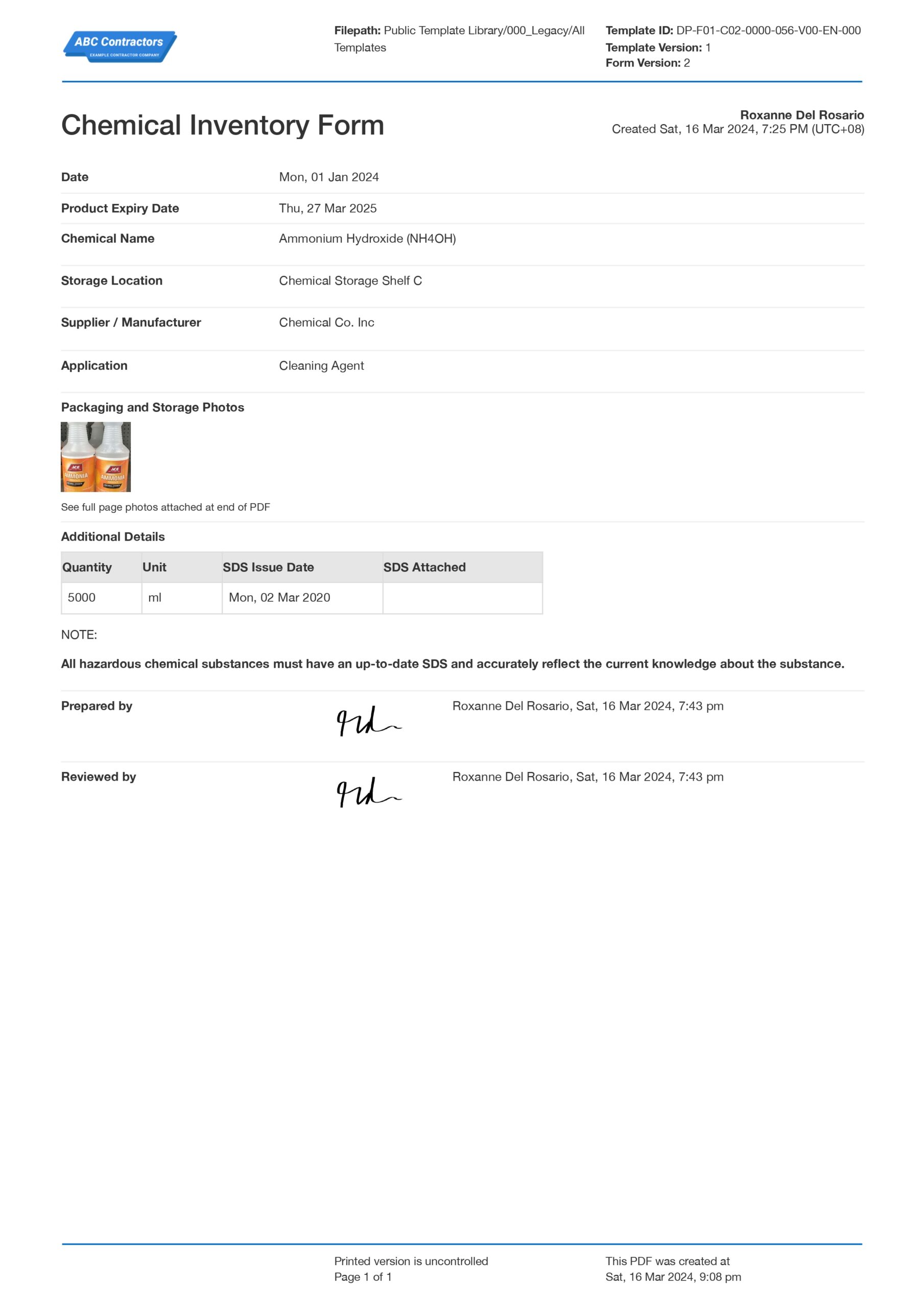Dashpivot Article Page – Chemical Inventory Requirements
Chemical Inventory Requirements: An Essential Guide
In this article, we will be giving you a guide on how to store your chemicals properly and show you an example of how to make your chemical inventory form.

Chemicals in the industry
Chemicals are widely used in the industry. They are commonly found in production industries as raw materials that are added to their production process. However, not all chemicals that are used as raw materials are friendly to people and the environment. To illustrate this point, consider the following example: Chromium, ammonia, and mercury are widely used as solvents, reagents, and cleaning agents. However, these chemicals are highly toxic to both humans and the environment to the point that they can cause permanent damage. Because of this, we have devised a program to keep track of these hazardous chemicals and identify their adverse effects on us and on the surroundings. The program is a document that registers all chemicals in the workplace and provides important details about it. This record is called the Chemical Inventory.
What is a chemical inventory?
A chemical inventory is a database that contains all of the chemical substances and mixes that are used by a company, to which the database may range from being simple to complex. An extensive compilation of every relevant detail on the identity, classification, storage, and safe use of chemicals and mixtures is the purpose of this tool. These details are either connected to or added by information about the use of the chemicals inside the company they pertain to.
What are the chemical inventory requirements?
Now that we have discussed what a chemical inventory is, we will now delve into what is required to make one. What will be discussed in this section is the vital information needed when making a chemical inventory. These are:
Accurate Chemical Identification
This provides all relevant information that identifies the chemical. This eases the employees in to finding and searching for the intended chemical to be viewed or reviewed upon. This removes confusion and provides an organised system for better access if there is a chemical spill emergency. When identifying chemicals, you could provide a unique code for each chemical to make identification easier.
Chemical Quantities
Chemical quantities should be controlled when storing chemicals. The best way to monitor the amount of chemical being stored is to record it in your chemical inventory. It is a must that this information is easily seen, especially for highly flammable substances. Storing more than
Storage Information
Storage plays a huge role in chemical safety, especially with highly reactive ones. They must be placed in areas where the safety data sheet requires them to be placed. That is why it is crucial to have this kind of information placed in the chemical inventory to help employees navigate where to properly stow them.
Safety Data Sheets (SDS)
A Safety Data Sheet, originally known as a Material Safety Data Sheet, is a comprehensive informative document created by a hazardous chemical's importer or manufacturer. It explains the product's chemical and physical characteristics. Important details, including toxicity, flash point, spill and leak procedures, storage recommendations, and exposure management, are all included in SDSs. It is necessary to have this document of every chemical to be provided as an attachment since this contains all necessary information on how to handle a specific chemical.
Regulatory Compliance
Regulatory compliance in an area, state, territory, or nation often places regulatory requirements on how to handle chemicals. Such regulations and requirements can be attached to your chemical inventory to help you navigate easily on audits. This will enable you to avoid any non-compliance, therefore any legal fines, and maintain company reputation.
Registry of Updates
It is unavoidable that there might be changes in operations and regulations. When these things happen,, chemical consumption and storage are often affected and changed. Because of this, the chemical inventory needs to be updated. When updating the chemical inventory, it is important that this is recorded so that changes can be traced. Having a registry of updates helps you in making your records easily auditable and promotes accountability in the organisation since information like who updated them and what is being updated, is provided.
Chemical Inventory Example
You can see a good example of a chemical inventory form below, which is typically one of the hard chemical inventory requirements.

Use this Chemical Inventory Format for free
What is the purpose of a chemical inventory?
In this article, we will provide you with reasons why it is essential to have a chemical inventory by breaking down all its purposes in your workplace.
Safety and hazard identification
It is much simpler to identify hazards and conduct risk assessments when you have a chemical inventory at your disposal. The list of potential risks that a chemical may come with is already included in the chemical inventory, and the safety data sheet also offers additional information that is more precise on the potential dangers that the chemicals may have. In the event that you have these readily accessible, the process of identifying hazards and conducting risk assessments will be much simplified for you. When it comes to coming up with a solution that eliminates or mitigates the hazards that are linked with the use of these chemicals, the fact that control methods are also specified on the safety data sheet also helps save time. To have more understanding about hazard identification, look at the definition of hazard identification.
Regulatory compliance
The OSHA Hazard Communication Standard states in section 1910.1200(a)(2) that "this occupational safety and health standard is intended to address comprehensively the issue of classifying the potential hazards of chemicals and communicating information about hazards and appropriate protective measures to employees and to preempt any state or political subdivision's legislative or regulatory enactments pertaining to this subject." Classifying chemical hazards and communicating information about hazards and protective measures to employees may include developing and maintaining a written hazard communication programme for the workplace, including lists of hazardous chemicals; labelling chemical containers in the workplace and those shipped to other workplaces; and preparing hazardous chemicals. Having your safety data sheet attached, and chemical inventory would prove helpful in maintaining regulatory compliance.
Access to safety data sheets
One of the most important things that must be done in order to comply with regulatory requirements is to provide information regarding the dangers posed by chemicals. This information is included in a safety data sheet. The Safety Data Sheet (SDS) contains information that includes the characteristics of each chemical, the potential risks to human health, the environment, and the environment's health, as well as preventive measures and safety precautions for the chemical's handling, storage, and transportation. When working with chemicals, it is necessary to have all of this knowledge in order to ensure the safety of the workplace and maintain regulatory standards.
Emergency response
Your chemical inventory includes a safety data sheet that details the procedures and protocols that should be followed in the event of skin contact, inhalation, ingestion, or exposure to the environment. When adversities of this kind arise, medical practitioners will find this knowledge to be of great use in determining how to treat injuries that have been caused by such particular substances. Not only does the Safety Data Sheet (SDS) provide information regarding the effects of a chemical on the human body, but it also contains information about the chemical's flammability and the agents that are used to battle fires. Your firefighting crew will be able to utilise this knowledge to make more informed decisions about the appropriate actions to take in the event that a fire is caused by a particular chemical incident.
Proper storage and handling
To keep chemicals safe, proper storage is a big factor that contributes to this. There are certain chemicals that require a temperature limit, exposure to air limit, and specific container properties to prevent them from forming hazardous reactions. This is where the chemical inventory excels. This document contains all this specific information on the items that a chemical requires when being stored. For example, hydrochloric acid with a 37% solution should be stored in a well-ventilated area away from direct sunlight and heatsources. It should be contained ina material made of polyethylene glass or PVC-lined metal, and must be tightly sealed and labeled properly. This kind of information can be found on the chemical inventory, which makes storing chemicals much safer and easier.
Waste management
Aside from proper storage, proper disposal is also a crucial aspect that companies must take note of when handling chemicals. There are certain chemicals that can cause serious and permanent damage to flora and fauna. To know this information, one must first take a look at the safety data sheet of a certain chemical, which is attached to your chemical inventory. The safety data sheet can show you information on a chemical’s effect on the environment and how to properly dispose of it. This will be a good guide on your waste management system, as it readily provides you with information on how to dispose of such chemicals. Furthermore, there is strong regulatory compliance when it comes to preserving the environment. Following disposal procedures on the safety data sheet can help you avoid legal fines.
Training Material
When it comes to teaching workers, particularly those who have just been hired, chemical inventories are a valuable source of knowledge. It is included in the document all of the necessary information on the hazardous chemicals that are used by the organisation, as well as the appropriate methods for storing them in the appropriate manner. In addition, it is beneficial to disseminate the knowledge on these substances via toolbox talks, which are informal gatherings that are held for the purpose of conducting safety discussions among workers. The personnel will be better able to remember the necessary safety steps to take while handling the chemicals that are a part of the operations if they are reminded about this.
Improve chemical inventory management in the workplace by using digital solutions
If we are being honest, manually making the chemical inventory is such a tedious job, especially when updating it. This could be a hassle for companies that are using a lot of chemicals in their processes. The pen-and-paper method is also susceptible to human error. The constant transferring of data onto the computer has a high risk of committing such error. Fortunately, there is now a solution to this. With the new Dashpivot digital chemical inventory software, you can streamline chemical inventory reporting to reduce errors and compliance issues.
Your chemical inventory form should be standardised so that you can be certain that your records are accurate and include all of the necessary information the very first time on every occasion. With the Dashpivot digital chemical inventory software, you can utilise the pre-built chemical inventory form and then use the drag-and-drop form builder to modify it to meet the requirements of your project specifically.
Furthermore, you can just use your mobile phones or tablets to enable real-time inventory monitoring, changes, and data input from any location and at any time. Any changes that are made will be instantly synchronised with the office after they have been submitted. To improve accountability and lower the possibility of mistakes or inconsistencies, take pictures inside the platform and connect them to inventory records to verify chemical information, location, and condition. You can add smart tags for simple organisation and searching, apply picture markup to emphasise crucial information, and automatically timestamp photos taken using the chemical inventory programme.
All these and more when using the Dashpivot digital chemical inventory software. To learn more about it, click here at: Dashpivot digital chemical inventory software

Material Safety Data Sheet
Document chemicals and hazardous materials with this comprehensive safety data sheet.

Job Hazard Analysis
Easily complete a JHA on any device, and then keep all of your job hazard analyses neatly organised and searchable.

PPE Request Form
Automate PPE requests and approvals with this smart PPE request form to save everyone time and ensure no PPE request ever gets missed or forgotten.
